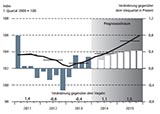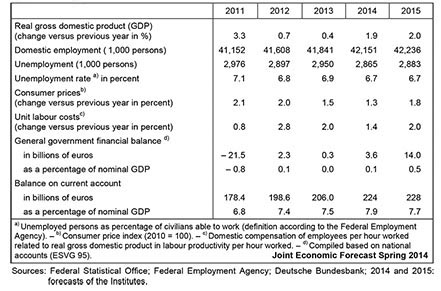
Upturn in German Economy, but Economic Policy Creates Headwind
The German economy is experiencing an upturn in spring 2014. Gross domestic product (GDP) is expected to grow by 1.9 percent this year. The 68 percent projection interval ranges from 1.2 percent to 2.6 percent. Domestic demand is the main driver of growth. Consumer prices will increase by a moderate 1.3 percent in 2014. The number of persons in employment looks set to rise steeply once again in 2014. Economic activity, however, will have to weather an economic policy headwind. The entitlement to a full pension as of 63 years is a step in the wrong direction and the introduction of the minimum wage will curb the rise in employment in 2015.
World production grew strongly in the first few months of 2014. Impetus particularly came from advanced economies, which have gained momentum over the course of the past year. The USA and Great Britain are experiencing an upturn and the economy in the euro area is slowly recovering from recession. A number of emerging economies, however, have been battling with capital outflows and currency depreciations since last summer.
Monetary policy in the advanced economies remains expansive; with base rates at zero percent or just above. The US Fed has announced that it will keep interest rates low, despite the steep fall in the unemployment rate; and the ECB lowered its main refinancing rate to 0.25 percent in November.
Fiscal policy in the advanced economies will also remain restrictive in 2014, albeit to a lesser degree than in 2013. In the USA the fiscal policy blockade that constituted a major threat in recent years has been lifted, with Republicans and Democrats reaching key compromises over the winter. Fiscal policy in the euro area is no longer expected to be overly restrictive this year.
World production will expand at around the same pace as in the second half of 2013 during the forecasting period. The upturn will even gain impetus somewhat in the USA. Growing consumer and corporate confidence suggest that the euro area’s economy is expected to recover further. The burden of debt costs on companies and households will decrease, asset prices will rise once again in most countries and labour markets will stabilise. The dynamics of demand, however, will remain subdued, as targeted improvements in the balance sheets of banks and companies, and in the net asset position of households, have not yet been achieved; and the difficult situation in the labour market will continue to curb private consumption. Production increases in emerging economies are not expected to be quite as high as in recent years. All in all, the Institutes forecast a 2.9 percent increase in world production in 2014, and a 3.1 percent increase in the following year.
Current developments in the capital markets of emerging economies pose a threat to the world economy. Although exchange rates have now stabilised after January’s depreciations, individual events such as, for example, the Russia-Ukraine conflict, could trigger further capital outflows and currency depreciation in the future.
The unexpectedly steep decline in price pressures in the euro area poses a further threat to the economy. Such surprisingly weak price pressures mean that the real burden of old debts are higher than expected. The euro area is nevertheless a long way off deflation, or a falling price level that is perceived by companies and households as an ongoing process; and inflation is expected to pick up in the course of the current recovery.
The German economy is experiencing an upturn in spring 2014. Production has been increasing for a year, employment is rising faster than previously and sentiment among companies and consumers has improved considerably. The number of incoming orders is also rising. Although demand from emerging economies is now less lively, the economy is recovering in the rest of the euro area, which is Germany’s most important market. Credit conditions remain extremely favourable and uncertainty, especially with regard to the euro crisis, has continued to fade. Against this background, investment activity gained momentum, whereby construction activity was also been boosted by the mild winter.
Federal Republic of Germany
Key Forecast Figures

Click on table to enlarge
The Institutes expect production to increase significantly during the rest of the year. Domestic demand will be the driving force. Low interest rates will continue to stimulate investment in residential construction. Public sector construction investment will be supported by the strong financial position of many local authorities, while money from the flood relief funds will also boost investment activity this year. Exceptionally good financial conditions for companies, rising capacity utilisation rates, as well as the high levels of confidence reported in business surveys also point to a further acceleration in corporate investment. The biggest contribution to aggregate economic production, however, will be made by private consumption, which will be bolstered by a faster increase in disposable income and rising employment levels. International trade, by contrast, is not expected to provide any impulse. International demand for German products should pick up slightly in line with the world economic dynamic. However, the steep increase in equipment investment, which typically has a high import content, will lead to a larger increase in imports than in exports.
All in all, gross domestic product is expected to increase by 1.9 percent this year. The 68 percent projection interval will range from 1.2 percent to 2.6 percent. Aggregate economic production will continue to grow and unemployment will fall. The continued increase in the potential workforce is taken into account in these forecasts. Although the potential workforce will shrink per se due to the introduction of full pension entitlement as of 63 years of age in July 2014, persisting high levels of net immigration will more than compensate for this decrease. Upward pressure on wages will increase as a result of the improved labour market situation. The rise in consumer prices, however, will be very moderate at 1.3 percent. Lower energy prices compared to last year have an impact here; excluding energy, the core inflation rate of 1.6 percent will correspond more to the economic situation. Fiscal policy will mainly remain expansive due to the expansion of pension benefits planned by the German government. Thanks to the favourable economic situation, and resulting income increases, however, the German Federal State’s financial position will continue to improve. The budget surplus will total 3.6 billion euros or 0.1 percent of nominal gross domestic product this year.
The rate of expansion in 2015 will remain high. No positive impulses can be expected from international trade, on balance, but the uptick in domestic demand will remain strong. It will nevertheless be curbed by the introduction of a nationwide hourly minimum wage of 8.50 euros scheduled for 1 January 2015. The economic implications of this measure are extremely difficult to assess, partly because such state intervention in the German labour market is unprecedented to date. Drawing on the experiences of other countries is of little use, since their institutional frameworks bear little similarity to that of Germany. A large number of the persons who will be affected have mini-jobs, a form of employment that does not exist in other countries. Moreover, the minimum wage in Germany will probably apply to a far larger share of employees than was the case in most of the other countries when a minimum wage was introduced. Many suppositions and assumptions must therefore be made to quantify the implications of a minimum wage for the labour market and economic developments. Taking into account exceptions and transitional provisions, the Institutes estimate that around four million employees will be affected by the introduction of a minimum wage in 2015, and that around 200,000 jobs will be initially lost that year as a result. Aggregate hours worked should drop by 0.3 percent as a result. The decrease in gross domestic product, however, will probably only total 0.1 percent, as the jobs lost have comparably low productivity levels.
Taking the minimum wage effect into account, gross domestic product is expected to increase by 2.0 percent in 2015. The high number of working days compared to 2014 is also a contributing factor; and aggregate economic production adjusted for working days will increase by 1.8 percent. The rise in consumer prices will accelerate to 1.8 percent, of which 0.2 percentage points will be due to the pass-through of a wage increase fuelled by the introduction of the minimum wage. The annual average number of unemployed persons will rise slightly by 18,000 persons, while the unemployment rate will remain at 6.7 percent. Fiscal policy will be slightly expansive. The State’s budget surplus will increase to 14 billion euros or by 0.5 percent in relation to nominal gross domestic product.
In addition to the difficulties related to assessing the implications of a minimum wage, another uncertainty factor for the forecasting period is how relations between Russia and the European Union will develop in view of the Russia-Ukraine conflict. Sanctions on cross-border trade in goods and capital, and especially limitations on Russian oil and gas exports, would have a serious impact on both Russia and Germany.
Economic policy is creating a headwind for the German economy. The new federal government considers four areas as strategically important: the improvement of social participation opportunities and equitable participation through improved education and labour market integration, investment and innovation policy, the energy policy turnaround and the stabilization and deepening of European economic and monetary union. The majority of the Institutes believe that many of the measures taken will not lead to the achievement of goals in the area cited above, but will merely create new problems. The nationwide minimum wage will tend to reduce the employment prospects of low-skilled workers overall and – since transfers are reduced — it will hardly help to reduce poverty at all. The entitlement to a full pension as of 63 years of age counteracts efforts to adapt pension entitlements to rising life expectancy and will instead serve to curb production potential. In public sector investments there is an excessive emphasis on additional expenditure per se. This may be reasonable in areas like infrastructure and education, but improvements in quality are equally as important and have been neglected to date. The way in which the energy policy turnaround is being implemented is curbing investment due to the uncertainty that it entails. Stability risks also slumber on in the euro area. The key issue now is to clean up bank balance sheets in the crisis-afflicted countries in order to avoid a long phase of subdued economic development and the risks – including for price stability – that this entails.
The DIW Berlin and WIFO consortium did not share the assessments of the majority of the Institutes in key points of economic policy. Their views are presented in the section entitled: “A Different Opinion”.
Download the complete forecast (in German; PDF, 2.5MB)
Members of the Joint Economic Forecast Project Group:
Institut für Wirtschaftsforschung Halle
www.iwh-halle.de
in cooperation with:
Kiel Economics
www.kieleconomics.de
Deutsches Institut für Wirtschaftsforschung e.V.
www.diw.de
in cooperation with:
Österreichisches Institut für Wirtschaftsforschung
www.wifo.ac.at
Ifo Institute – Leibniz Institute for Economic Research at the University of Munich
www.ifo.de
in cooperation with:
KOF Konjunkturforschungsstelle der ETH Zürich
www.kof.ethz.ch
Rheinisch-Westfälisches Institut für Wirtschaftsforschung
www.rwi-essen.de
in cooperation with:
Institut für Höhere Studien Wien
www.ihs.ac.at
